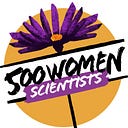Around the world with 92 pods—Meet 500 Científicas Ecuador
500 Women Scientists is thrilled to introduce our Meet the Pod blog series, where we will highlight our local chapters from across the world. We’re especially excited to introduce the amazing people who lead and participate in these pods in an effort to help make the world a more equitable place, all while juggling demanding STEMM careers and busy lives.
We’re beginning this tour with 500 Women Scientists’ pods in Ecuador — home to the Galapagos Islands; over 6000 species of orchids; the Las Vegas tribe — one of the oldest civilizations in the world; and the Chimborazo Volcano near Riobamba — the point on earth closest to the sun.

Quick Facts about 500 Científicas Ecuador:
Location: Quito, Ecuador
Member Count: 14
STEMM Fields represented:
- Chemical Engineering
- Biology
- Computer Science/Cybersecurity
Social Media:
Instagram: @500cientificasec
Facebook: 500 Científicas Ecuador
Pod Mission: Our mission is to promote STEM careers for young girls in Ecuador. Our aim is to achieve a diverse and inclusive scientific community.
Our People: Pod Leaders / Coordinators

- Andrea Zambrano Cobos—Professor in Faculty of Medicine at Pontificia Universidad Católica del Ecuador
- Pamela Rivera Parra —Professor in Biology Department at Escuela Politécnica Nacional
- Anabel Zabala Peñafiel—PhD candidate at Fundación Oswaldo Cruz
- Paula Iturralde Pólit— PhD candidate at Universidad de Costa Rica
Q & A
How did the Ecuador pod come to being and how is your mission relevant to the larger STEMM community in your country?
The number of Ecuadorian researchers has increased in the last few years. However, women are still under-represented in the science community. Our aim is to make the work of Ecuadorian women scientists visible and present it to high school and undergraduate students to inspire them to pursue a career in science.
It is important for us to build a supportive community for female scientists and give them a space to become role models, to work as a platform for featuring their work.
Our mission is particularly important in Ecuador and as well as in other South American countries, where education is a privilege and underprivileged communities lack access to all levels of education. Therefore, it is fundamental to show that women can be scientists and that we exist and do research.

Our pod started as a personal idea of the importance of a community as 500WS in Ecuador, as a need to have a space to share and work with other women. Since then, we have built up to more than 15 active members and an equal number of collaborators, with ages ranging from 20 to +45 and several different fields of study. We use social media to broadcast our work, and everyone is welcome.
Tell us about your past activities and successes. Are there any favorites that you want to share, and how they are important to your community?
Our first and only in-person activity was on February 11th, 2020, to celebrate the Day of Women and Girls in Science. We held a meet and greet with Ecuadorian women, talking about their research informally. Through this event, we wanted to make the work of Ecuadorian women scientists visible and invite more women to join our pod. There were many young attendees — so many that the bar had to close the doors because there was no place for so many people (pre-pandemic times).

During the pandemic, we created a Youtube Channel to share short videos about our work. This included our new pod members as well as other scientists interested in sharing their research. The videos show what it takes to become a woman scientist, including the challenges and the rewards. We shared them with high school science teachers who broadcast them to their students. For us, it was very inspiring that after watching the videos, many students contacted the women featured in the videos with follow-up questions and expressed interest in their work.
During the last six months, we have been producing material to share on our social media accounts. For example, on March 8th, we shared audio files in which different scientists shared experiences in which they felt discriminated against for being women.
Have you formed any local connections with schools, universities, or grassroots STEMM organizations?
In April of this year, our pod joined the Ecuadorian Network of Women in Science (REMCI), which promotes and empowers women in academia. REMCI has a high degree of impact in Ecuador and South America and has even provided support to the Ecuadorian chapter of the Organization for Women in Science for the Developing World (OWSD) to increase the international representation of Ecuadorian women in science.
What future plans does your pod have?
We are focused on enthralling young people in science and science communication. We use social media to broadcast information and share the challenges and opportunities of being women in science. We plan to increase the number of activities, reach more followers, and encourage young students to never give up on their dreams.
We also aim to grow stronger and establish a supportive environment among the active members. We have planned a workshop with the pod members to share and teach each other new skills.
••••••••
Feeling inspired? Want to join a pod? Learn more here. [Interview with Paula Iturralde and Andrea Zambrano — Ecuador Pod Leaders; Edits by Kara Bocher, Pods Coordinator & Anushka Gole, Director of Communications at 500 Women Scientists]
